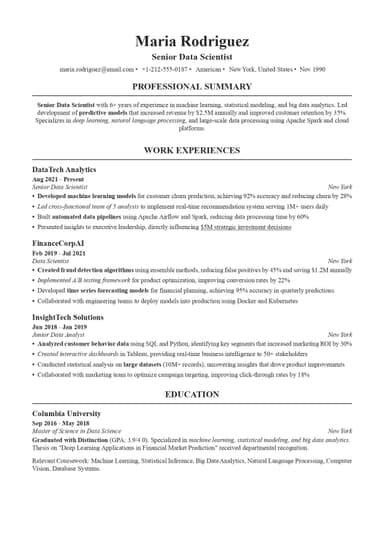How to Write a Professional Letter of Resignation: Templates & Examples 2025

Writing a letter of resignation can feel overwhelming when you're already dealing with the stress of leaving your job. After all, submitting a poorly written one or handling your departure unprofessionally can damage your reputation and hurt future career opportunities.
On the other hand, a well-crafted letter of resignation protects your professional reputation, maintains positive relationships with colleagues, and sets you up for success in your next role. This guide will teach you how to write and submit a professional one and how to quit a job professionally, without burning bridges.
- A letter of resignation is a formal document that informs your employer of your intent to leave your position.
- Professional resignation letters should be concise, positive, and include essential details, such as your last working day.
- A two weeks' notice period is the standard practice, but you should always check your employment contract for specific requirements.
- Always have a face-to-face conversation with your supervisor before submitting the written document.
What Is a Letter of Resignation?
A letter of resignation is a document that officially notifies your employer of your intention to leave your current position. It serves as legal documentation of your departure date and helps ensure a smooth transition process.
Unlike casual verbal resignations, a written one provides clear proof of your intentions and protects both you and your employer; the paper trail shows you followed proper procedures and gave appropriate notice.
The resignation letter typically includes your last working day, a brief reason for leaving (though this is optional), and an expression of gratitude for the opportunities you've had. It's a fundamental part of workplace etiquette that demonstrates respect for your employer and colleagues while keeping doors open for future networking opportunities.
Most importantly, this document becomes part of your permanent employment record. HR departments keep these letters on file, and they can influence how former employers respond to reference checks or professional references down the road.
7 Essential Components of a Resignation Letter
Here are the main components of a resignation letter:
#1. Header and Date
Start with your contact information at the top, just like you would with any business letter, by including your full name, address, phone number, and email address. Below that, add the current date, followed by your supervisor's name, title, and the company's address.
This formal structure shows you understand professional communication standards and makes it easy for HR to file your letter properly.
#2. Formal Salutation
Address your immediate supervisor or manager directly using their proper title; for example, "Dear Mr. Smith" or "Dear Ms. Johnson" works perfectly. If you have a close working relationship, first names are acceptable but not too formal.
You should avoid generic greetings like "To Whom It May Concern", as you should know exactly who you're writing to.
#3. Statement of Resignation
Clearly state your intention to resign and include your last working day, for example:
I am writing to formally notify you of my resignation from my position as Marketing Coordinator. My last day of work will be [date].
Don't dance around it or bury the lead; your manager should understand your intentions within the first sentence.
#4. Reason for Leaving (Optional)
You're not required to provide detailed explanations about why you're leaving; a simple statement like "I have accepted a position that will further my career goals" is sufficient.
Keep it brief and positive; this isn't the place to air grievances about workplace issues or explain your burnout problems, career change, or personal circumstances in detail.
#5. Gratitude and Positive Tone
Express genuine appreciation for the opportunities you've had, work skills you've developed, or relationships you've built. So, even if your experience wasn't perfect, focus on the positives.
For example, you can say:
I'm grateful for the professional growth opportunities and the supportive team environment I've experienced here.
#6. Transition Assistance Offer
You should show your professionalism by offering to help train your replacement or wrap up current projects. This gesture demonstrates goodwill and helps maintain positive relationships.
Here’s what you can write:
I'm committed to ensuring a smooth transition and am happy to assist in training my replacement or completing outstanding projects.
#7. Professional Closing
End with a formal closing like "Sincerely" or "Best regards," followed by your typed name and signature (for printed letters).
Extra Tips for Writing Your Letter of Resignation
Now, let’s have a look at some additional advice on how to write a solid letter of resignation:
Never submit a resignation letter without speaking to your supervisor first. This shows respect and prevents your manager from being blindsided by a formal document. Schedule a private meeting and have an honest conversation about your decision; only after this discussion should you submit your written resignation letter.
You should decide whether to submit a printed letter or send a professional email. In traditional office environments, a printed letter is often the preferred option, while a well-formatted resignation email may be more suitable for remote teams or tech companies. Consider your company culture and follow established norms for formal communications.
Maintain a respectful tone throughout your letter, regardless of your reasons for leaving. Remember, this document goes into your permanent file and could be referenced years later.
For this reason, you have to focus on the future rather than dwelling on past frustrations or workplace issues. So, even if you're leaving due to problems, keep those discussions separate from your formal resignation letter.
Your resignation letter reflects your professionalism, so make sure it's error-free; check for typos, grammar mistakes, and formatting issues. Additionally, read it aloud to ensure the tone sounds professional and respectful, and have a trusted friend or family member review it as well.
Resignation Letter Templates by Situation
Here are several templates that illustrate what a letter of resignation should look like in a few different situations:
Professional Resignation Letter Example
The following example illustrates how a marketing specialist handles her resignation professionally:
Sarah Johnson
123 Main Street
Anytown, ST 12345
sarah.johnson@email.com
(555) 123-4567
March 15, 2025
Michael Chen
Marketing Director
TechStart Solutions
456 Business Ave
Anytown, ST 12345
Dear Michael,
I am writing to formally notify you of my resignation from my position as Marketing Specialist with TechStart. My last day of work will be March 29, 2025.
I have accepted a Senior Marketing Manager position with another company that offers significant opportunities for career advancement and aligns with my long-term professional goals. This decision was not made lightly, as I have genuinely enjoyed working with our team and contributing to TechStart's growth.
During my remaining time, I am committed to ensuring a smooth transition. I will complete the Q1 campaign analysis report, update all client files, and work with Jennifer to transfer my ongoing projects. I'm also happy to assist in training my replacement once they're selected.
I want to express my sincere gratitude for the mentorship and growth opportunities you've provided over the past two years. The experience I've gained here has been invaluable to my professional development.
Thank you for your understanding, and I look forward to maintaining our professional relationship in the future.
Sincerely,
Sarah Johnson
Why this works: Sarah clearly states her departure date, briefly explains her reason without going into excessive detail, offers specific transition assistance, and maintains a positive tone throughout.
Common Mistakes to Avoid When Writing a Letter of Resignation
The mistakes you should avoid making when crafting a letter of resignation include:
Your resignation letter isn't the place to air grievances or provide an exhaustive list of workplace problems, so you should keep your reasons brief and professional.
Instead of: "I'm leaving because management doesn't listen to employee feedback, the workload is unreasonable, and there's no room for advancement."
Write: "I have accepted a position that better aligns with my career goals and offers new opportunities for professional development."
Even if you're leaving due to serious issues, save those conversations for your exit interview, where they can be addressed constructively.
Most employment contracts specify notice requirements, but a two weeks’ notice letter is standard in most industries; additionally, some senior positions may require 30 days or more.
Check your contract and give appropriate notice whenever possible. If you absolutely cannot provide standard notice, acknowledge the inconvenience and offer alternative solutions like remote assistance during transition.
No matter how frustrated you are, you should avoid emotional language or accusations in your resignation letter. As previously mentioned, this document becomes part of your permanent employment record, so it needs to be professional.
Failing to offer help during your departure can leave a negative final impression. Even if you're eager to leave, showing willingness to support the transition demonstrates maturity and professionalism. Therefore, be specific about what you can do: complete projects, train replacements, document processes, or transfer client relationships.
You should always keep copies of your resignation letter and any related correspondence, as this protects you legally and can be useful for future reference. Also, make sure you store both digital and physical copies in a safe place since you might need them for unemployment claims, legal issues, or simply to reference dates for future resume making.
What Happens After You Submit Your Letter of Resignation?
Here’s what happens once you submit your letter of resignation:
Exit Interview Process
Most companies conduct exit interviews to understand why employees leave and gather feedback about their experience. Effective ones can provide valuable insights for improving workplace culture and reducing turnover, so this is your opportunity to provide constructive feedback that could improve the workplace for others.
Prepare for common questions about your experience, management effectiveness, and suggestions for improvement. Be honest but diplomatic; this isn't the time to settle scores or vent frustrations. Plus, you can use your exit interview tips to make the most of this conversation and maintain positive relationships.
Final Paycheck and Benefits
It’s vital to understand your rights regarding final compensation, including:
- Accrued vacation time, as some states require payout of unused vacation days
- Final paycheck timing, since federal and state laws dictate when you must receive your final pay
- Benefits continuation, including COBRA health insurance options and 401(k) rollover procedures
- Expense reimbursements, which refer to any outstanding business expenses
Review your employee handbook or speak with HR to understand your company's specific policies and your state's requirements.
Return of Company Property
Create a checklist of all company property you need to return, such as:
- Laptop, tablet, or other electronic devices
- Company credit cards and purchasing cards
- Access badges, keys, and security tokens
- Company vehicles or equipment
- Confidential documents or proprietary materials
Some companies provide a formal checklist during your exit process, but being proactive shows professionalism and ensures you don't forget anything.
Reference Requests
Finally, it’s time to secure references for your future job search.
Approach supervisors, colleagues, and clients who can speak positively about your work and ask them to be your reference. If they accept, provide them with:
- Your updated resume
- A brief overview of the types of positions you're seeking
- Specific examples of projects or achievements they might mention
- Your contact information for easy follow-up
Also, consider using a professional references tracker to stay organized throughout your job search.
Letter of Resignation vs. Two Weeks’ Notice
Many people use terms “letter of resignation” and “two weeks’ notice” interchangeably, but they serve slightly different purposes:
- A letter of resignation is a formal document that officially notifies your employer of your intent to leave.
- A two weeks notice represents the standard timeframe for advance notification (which can be verbal or written)
Your resignation letter typically provides your two weeks' notice, but the notice period itself can vary based on your position, contract, or company policy.
Legal Considerations and Best Practices
Finally, here are several legal considerations you should have in mind when resigning from a position:
Understanding Your Employment Contract
Before submitting your resignation, review your employment agreement for:
- Notice period requirements: Some contracts require 30 days or more.
- Non-compete clauses: There might be restrictions on working for competitors or starting competing businesses.
- Confidentiality agreements: Check for ongoing obligations regarding proprietary information.
- Non-solicitation clauses: The contract might also include rules about recruiting former colleagues or clients.
If you have questions about contractual obligations, consider consulting with an employment attorney, especially if you're joining a competitor or starting your own business.
At-Will Employment Considerations
Most U.S. employees work "at-will," meaning either the employer or employee can end the relationship at any time, with or without cause. However, this doesn't mean you should skip a proper resignation process.
Still, even in at-will situations, providing appropriate notice and submitting a professional resignation letter protects your reputation and maintains positive relationships.
Documentation and Record-Keeping
Maintain thorough records of your resignation process that will include:
- Copies of your resignation letter and any email correspondence
- Documentation of verbal conversations about your departure
- Records of company property returned and final paycheck details
- Contact information for key colleagues and supervisors
This documentation can be valuable for unemployment claims, legal disputes, or simply for maintaining accurate employment records for background checks.
Preparing a Resume for Seeking Your Next Role
If you haven't already, now's the time to update your resume with our professional templates and prepare for your job search. You should consider:
- Adding your greatest and most recent accomplishments and responsibilities
- Updating your skills and qualifications with new competencies
- Refreshing your resume summary to reflect your career goals
- Gathering quantifiable achievements from your current role
The best way to make this process easier is to use our resume builder tools, which will make your resume ATS-friendly and professionally format it for your next opportunity!
Final Thoughts
Writing a professional letter of resignation demonstrates your maturity and helps maintain positive relationships as you advance in your career growth.
This document becomes part of your employment record and can impact future opportunities, so take time to craft a thoughtful, respectful letter that reflects well on your character and work ethic. The extra effort you put into communication often pays dividends through strong references, recommendations, and professional networking relationships.
As you transition to your next role, remember to browse resume examples for your next role and learn how to create an effective resume that showcases your growing experience and accomplishments!

